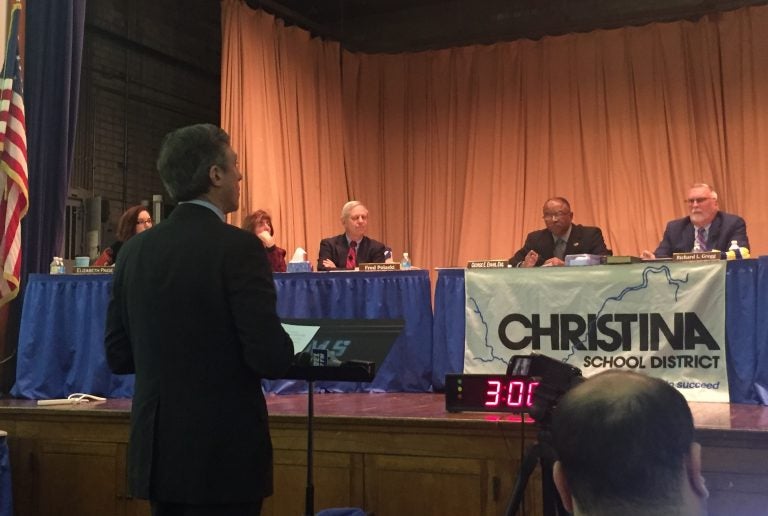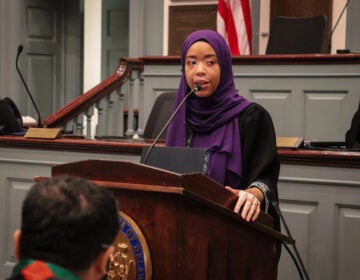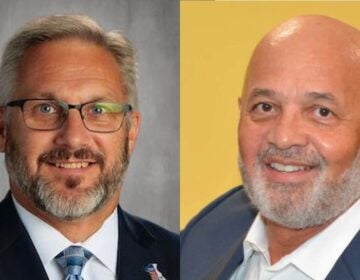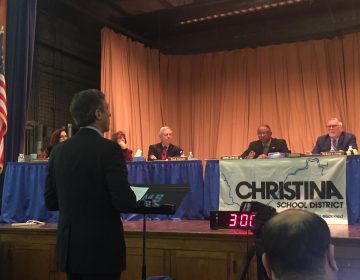School board approves landmark plan to consolidate five Wilmington schools
A divided Christina school board gave guarded blessings Tuesday night to a plan by the Carney administration to consolidate five of the lowest-performing schools in the state.

Delaware Gov. John Carney addresses the Christina School District board Tuesday. (Cris Barrish/WHYY)
A divided Christina school board gave guarded blessings Tuesday night to a plan by the Carney administration to consolidate five of the lowest-performing schools in the state — all of them in Wilmington.
The board voted 4-2 with one abstention to close three struggling and under-used Wilmington elementary schools and expand two other schools into buildings serving Kindergartners through eighth graders.
Approval of the Memorandum of Understanding with the state unveiled in November paves the way for Stubbs, Elbert-Palmer, and Pulaski schools to shut their doors after the 2018-19 school year.
The two other schools affected — Bancroft Elementary and Bayard Middle — would be refurbished into schools serving first- through eight-grade students.
The session was at times testy, and saw member Elizabeth Paige walk out right before the vote when President George Evans would not let her respond to something another member said. Paige voted no along with John Young. Angela Mitchell abstained.
Voting yes were Evans, Fred Polaski, Meredith Griffin Jr. and Harrie Ellen Minnehan.
A handful of people who addressed the board, including parents in the district, urged members to hold off on approval because the community was not asked to provide input until after the closure and expansion plan was already developed — a sentiment shared by both Paige and Young.
Rep. John Kowalko, D-Newark, urged the board to vote no, saying the plan was “frighteningly sparse on monetary issues,” and the children would be “herded into monolithic structures better suited as a barracks.” He said the younger students would face an “intimidating experience” being with middle school students in schools that already have serious disciplinary problems.
Paige seconded that notion.
“The feeling that in the community that we’re just warehousing students is unsettling to me,” Paige said.
Noting that Gov. John Carney was going to ask the General Assembly for $15 million in capital dollars to renovate Bayard and Bancroft, Kowalko said he would not vote to authorize that money but would — if the board voted no — work tirelessly to get $15 million to invest in ways to create smaller class sizes and improve academic outcomes.
“If this MOU is not hocus pocus, it’s an outright hoax perpetrated on the children of Wilmington,” Kowalko said.
Governor: ‘Just a first step’
Carney, who initiated the consolidation effort and partnership with the district about six months ago, addressed several questions during the three-hour session before the vote.
“This is just a first step,” he stressed. “This is a framework for us to process forward.”
After the proposal passed, the governor was exhausted but relieved.
“The message to the children and their families is we are going to reinvest in your children’s school and we’re going to do a better job in providing services for their children,” Carney told a handful of reporters. “We’re going to address some of their psychological and emotional needs. We’re going to make sure they are successful as they move into high school.”
Evans said the move was necessary for the high-poverty schools with longstanding issues of low performance.
“We’re talking about smaller class sizes. We’re talking an upgrade to these facilities. We’re talking about adding instructional coaches in math and reading. We’re talking about reading specialists,” Evans said.
“We’re talking about a plan on our side that has been focused on by our principals and our instructional classroom leaders, the teachers within the classroom.”
Carney’s office had wanted the three elementary schools to shutter their doors at the end of the current school year, but the board and district balked at such a hasty timetable.
Those students will be sent to what are currently Bayard Elementary and Bayard Middle schools, which will be retrofitted to accommodate elementary students on one floor and middle school kids on another.
The first change will take effect this August, however, when Stubbs — which is less than 60 percent full, far below capacity — will begin its conversion into what is being called a “Dual Generation Center” with the state providing $2 million toward that effort.
The center would provide early education services for children from birth through pre-school, plus before- and after-school care. Under the proposal, the centers will offer assistance for adults in areas such as parenting skills, literacy, financial education, high school diploma preparation, and job training.
Plans for Pulaski and Elbert-Palmer have not been finalized, but district officials have said they will work with residents and government officials to determine how they can best be used. Christina plans to retain ownership of the buildings in the event that enrollment increases and they need more city schools.
Carney, who took office nearly 13 months ago, has targeted the Christina schools for intense intervention because they are among the lowest performing in Delaware.
For example, less than 10 percent of Bayard Middle students were proficient in math, English and science last year, but 98 percent of the sixth, seventh, and eighth graders were promoted – a reality that Carney told WHYY is “bordering on being immoral.”
Consolidation ‘right for us to pursue’
Proponents of consolidating the high-poverty schools – all located in high-crime sections of Wilmington – tout the increased resources and facility upgrades the new schools would receive.
Bancroft and Bayard would get reading specialists and instructional coaches in math and reading, two subjects where proficiency ranges from 3 to 23 percent in the five targeted schools. In none of the schools are more than one in four children up to state standards in math, English or science.
The schools, which have high disciplinary rates, would also get more support for behavior needs, as well as student health centers. There would be more career, foreign language and technical education offerings, and after-school programs. The school day and year also would be lengthened as officials see fit.
School leaders would have more flexibility to run their buildings, and teachers would get more training and support, such as ways to teach in an urban environment.
The plan does not, however, provide higher pay for teachers or other financial incentives to remain in the new schools. Veteran educators have said teachers often leave those schools because of low academic performance and disciplinary issues with students. Almost all of the pupils are from sections of a city suffering from a longstanding plague of gun violence, with younger teenagers being many of the shooters and victims.
The board had given preliminary approval to the plan in December, but that was contingent on delaying the changes for a full year until the 2019-2020 academic year.
The board also asked for a 2 percent annual increase to $1.5 million in state funding toward the initiative, and wanted the state to pay the full cost of renovations to buildings, rather than the usual 60 percent.
Carney appeared reluctant to accede to the demand for a delay, saying, “We can’t afford to wait.”
But he relented and the state made additional changes, agreeing to the 2 percent annual increase. However, the state only agreed to an 80 percent to 20 percent split in renovation costs.
Both parties continued negotiating, and the state has also agreed to ask the General Assembly for $15 million to renovate and retrofit Bayard and Bancroft.
Griffin echoed the governor in saying the board’s approval doesn’t mean the plan is set in stone but that it allows the process to proceed in earnest, including getting true costs estimates.
“It is not yet what it ought to be,” Griffin said. “And I have heard that we have to to do better from this point forward and ought to be held accountable by every person in the room in doing that. But that opportunity that stands now, I believe, is one that is right for us to pursue.”
WHYY is your source for fact-based, in-depth journalism and information. As a nonprofit organization, we rely on financial support from readers like you. Please give today.





